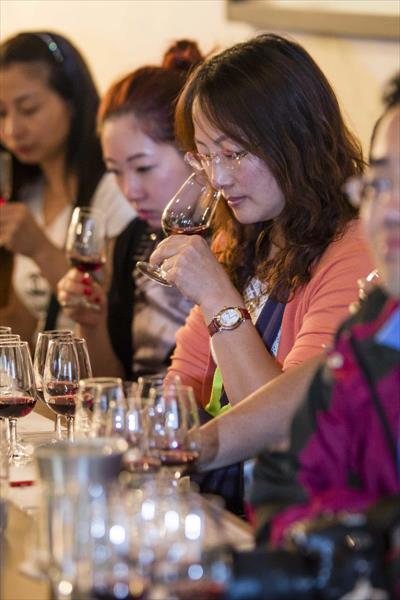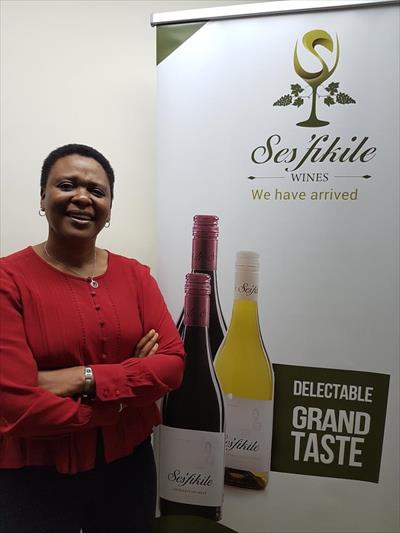| Business |
| Grape Expectations | |
| South African winemakers pursue multi-barrel strategy to become China's new toast | |
|
|
 For South African vintners, wine tasting events are a regular promotional tool (COURTESY PHOTO)
When Nondumiso Pikashe was teaching English and life orientation in a school in Cape Town, she thought there was no place for wine in her life. Her brother was a wine abuser and in her community, wine was regarded as something that created drunkards. But a decade later, she is the co-owner of a vineyard and teaching youngsters the potential of winemaking as a lucrative career path and a step to strengthen the national identity. The change, as the 49-year-old told Destinyconnect.com last year, came from her curiosity about the dichotomy of wine. "In the media, wine was always projected as an iconic beverage of elegance and sophistication but in my community, it was just looked down upon. I wanted to find out why there was this disconnect," she said. The curiosity made her explore the industry and she found a new world for black vintners, especially women. In 2006, after an earlier failed attempt, she set up her own winery, Ses'Fikile Wines, with three partners. Ses'Fikile, derived from Xhosa, one of the major languages spoken in South Africa, means "we have arrived." "It is a multifaceted concept," Pikashe told Beijing Review. "It refers to the arrival of women in a space previously reserved for men, to collaborate with them, and the arrival of South Africa itself in the global arena, to compete with other wine-producing regions." Ses'Fikile makes three wines but is yet to get major retailers to sell them. Pikashe has been told that "black brands do not work." As an emerging and black winemaker, she has to struggle to find sustainable funding and support. But she is optimistic about 2017. In March, Wesgro, the official tourism, trade and investment promotion agency for Cape Town and Western Cape Province, brought a delegation of Chinese importers of South African wine to Cape Town so that they could meet black and emerging winemakers and learn about their labels. "There are possibilities," Pikashe said. She has been to China four times and her mission is to crack the China market. "South Africa and China are within the BRICS-fold. It then becomes a natural affinity to [export to China]," she said. "Statistics also indicate a growing demand for South African wine in China. Lastly, the South African-Chinese import/export relationship is skewed. We need to increase South African products in China [to address the trade imbalance]."  Nondumiso Pikashe’s Ses’Fikile is keen to enter the China wine market (COURTESY PHOTO)
A gold mine The Chinese mainland has been an amazing discovery for the South African wine industry. In 2011, South African wine exports to it were below 5.5 million liters. But in five years they nearly trebled, according to statistics from the Department of Agriculture, South African Directorate of Food Safety and Quality Assurance. Today, China is South Africa's sixth largest export market for packaged wines by volume, and the largest in Asia. "The South African category in China grew exponentially in 2013-15," said Michaela Stander, Market Manager Asia at Wines of South Africa (WOSA). "Many in the trade cited [it] as the surprise of 2015 as [South African wine] took up seventh position in terms of origin for imported wine." While the top five export destinations for packaged South African wine exports are the UK, Germany, the Netherlands, Sweden and the United States, Stander said China continues to grow in importance as an export destination, accounting for 3.7 percent of total exports in 2016, at 15.76 million liters which signified a 19-percent increase over 2015, valued at 554 million rand ($42.14 million). "Some expected the South African category to decline somewhat in 2016, but instead we remained steady and are now in a position to overtake the United States for sixth spot," Stander added. "Across the world, we have noted a rising interest in South African wine as consumers are becoming more adventurous and keen to make new wine discoveries. South African wine is entering a new era." Buoyed by the trend, WOSA, a non-profit organization created to promote South African wine in major export markets, opened an office in Hong Kong in 2014. "Having a regional base means we can better capitalize on opportunities in the region. We can now more effectively support the growing number of South African wine companies trading in Asia, along with their importers, through increased education, networking and involvement in trade and consumer events," Stander said. This year, the South African wine industry will have a substantial presence in promotional events in China. In March Chengdu, a city in southwest China's Sichuan Province, famed for its panda breeding and research center, hosted the Great Wines of the Southern Hemisphere 2017 trade show in which South African vintners participated. On April 27, the Discover South Africa tasting event in Shanghai showcased over 200 wines. In May, SIAL China, a major food exhibition in Shanghai, will see the South African Department of Trade and Industry (DTI) put up a national pavilion with the participation of winemakers. Come October, WOSA will lead a three-city roadshow on the Chinese mainland. Finally, in November, South African wines will once again sparkle in ProWine China, an annual wine and spirit industry fair in Shanghai. When in China… Located on the picturesque Stellenbosch wine route in Western Cape, a prime tourist destination, Stellenbosch Vineyards is a 13-year-old company exporting its portfolio to 39 countries. The vineyard began to export to China from 2005, a year after its inception. It took part in the roadshows in China last year and was back in March at the Chengdu promotion. "We attended the roadshow to introduce our wines to local wholesalers and retailers who have an interest in buying from our agents," said Guy Kedian, Sales Manager at Stellenbosch. "I found the level of interest and the level of wine knowledge very high. In China last year we sold around 80,000 bottles." Stellenbosch's production in 2016 was around 8 million bottles, bringing in nearly $13 million. The top three destinations were the UK, Netherlands and Denmark. However, the opportunities come with challenges. Kedian outlined the barriers for his company in China: the vast distance, language barrier and a young wine culture in China, which requires an appropriate approach. On the other hand, this is a relatively untapped market with a large number of potential consumers who are well-heeled and different consumer behaviors more focused on authenticity and quality than on price alone. To overcome some of these challenges, Stellenbosch has modified part of its packaging and communication tools. More and more wineries are switching to Chinese labeling for China exports. While French wines have the lion's share of the China market with 40 percent, according to 2016 estimates by Grapewallofchina.com, a portal on Chinese wines and spirits, South Africa accounts for about 2 percent. So to grow the market share, South African agencies are making an integrated effort. Various organizations, from WOSA to the DTI, South African Tourism and the Western Cape Government, are working together to create a unified Brand South Africa experience. Wine tourism is an important part of this. Two-way traffic While South African winemakers have spotted opportunity in China, Chinese investors are also waking up to the potential of the industry. In 2011, Perfect China, a company from Jiangsu Province in east China, formed a joint venture with Hein Koegelenberg, CEO of La Motte Estate and Leopard's Leap Family Vineyards in Western Cape. Two years later, the venture, Perfect Wines of South Africa, bought the Val de Vie estate in Western Cape, the first Chinese investment in South Africa's wine industry. "The Chinese wine market is very important to our industry, and this first Chinese investment…is a clear indication of their interest in our wines and can lead the way to a bright future for the export of South African wine to the east," Koegelenberg said in a press statement. The joint venture exports South African wine not only to China, but also to Southeast Asian countries including Malaysia, Thailand, Singapore and Viet Nam. "China is set to become the second largest wine consuming country after the United States by 2020," Mareli Roux, Senior PR at La Motte, told Beijing Review. "We need to explore this opportunity. The online market is the new platform and an exciting opportunity. China will lead the way for the world when it comes to online sales." In 2015, there was more Chinese investment. Chinese electronics business owner William Wu bought a 51-percent stake in Swartland Winery in Cape Town. Wu said in a media statement that he had come with a market for the product. "The market is in China, where I have a ready demand for the quality and volume of wine Swartland produces. Swartland [is a] great investment [as] it is one of the few South African wineries of this size where the majority of grapes planted are red varieties—in which the Chinese market is most interested," he said. Copyedited by Nicole Bonnah Comments to zhouxiaoyan@bjreview.com |
|
||||||||||||||||||||||||||||
|
